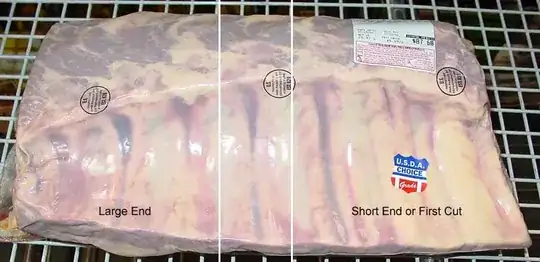I'm trying to compare prices for bone-in vs boneless beef rib roasts (aka standing rib roast aka prime rib aka ribeye roast). What is the weight of the bones as a percent of the total pre-cooked weight? Without this number it's impossible to compare prices. (Please no debate about which is better - save that for another thread.)
-
Of course it won't be an exact number, but a range or even a single data point would be helpful. 10%? 25%? I ended up buying a boneless roast that was $9/lb instead of a bone-in roast at $8.50/lb. That's only about 5% premium for not having bones so it seems like a better deal. Next time I buy bone-in I will cut it off and weigh it to answer my question. – mpoisot Dec 21 '17 at 14:29
-
3I've removing some comments which said essentially there's no answer because the numbers vary. This is a perfectly valid question, and if the answer is that there is a significant range, please write an answer saying so - preferably including some idea about what that range is. – Cascabel Dec 21 '17 at 20:52
2 Answers
The key factor is going to be the breed of cattle. Angus, a very high quality beef, also has heavy bone structure and a less favorable bone-to-meat ratio, where as limousine has a lighter bone structure with more meat-to-bone. Other breeds will vary as well, with hereford being (IMHO) the 'happy medium'. But, of course, each individual steer is going fall with a range of possible values rather than a constant factor.
Such value propositions really come down to individual taste and priorities. I suggest to that the comparison is really not just a xLb of bone-in vs. yLb of bone-out. The quality of getting bone-in (again, IMHO)is far superior. The attached rack provides for a degree of insulation and allows for a slower roast protecting the whole rack from over-cooking (a sin to be sure).
If you are stuck on just 'doing the math' if you are looking at a whole (7 bone) prime rib, the rack, the bones, along with the meat & fat attached to the bone that would remain if the rack were to be removed, will account for about 15% of the overall weight (give-or-take all of the variables mentioned - and more). For something 'more or less' than the whole prime (ribs 6-12) as you can see the bones will vary in size depending on whether you are at the short end or the large end of the rack.
This article, from Weber, offers a good deal of analysis of the rib roast in general and may provide some good additional information for you.
Bone-In vs. Boneless
Beef rib roasts are sold two ways—bone-in or boneless. There are several advantages to cooking a bone-in beef rib roast:
- Fat and connective tissue that surround the bones add moisture and flavor to the meat as it breaks down during cooking.
- Rich flavor from bone marrow may migrate into the meat during cooking.
- Bones slow the cooking of meat and limit the evaporation of moisture.
- Bones are easily removed after cooking and make a tasty treat for the chef!
Buy a bone-in beef rib roast whenever you can.
- 18,155
- 6
- 60
- 93
-
Good point about different breeds having different ratios of fat, muscle and bone. Another wrinkle to throw into the problem. – mpoisot Dec 21 '17 at 21:49
Cooked Beef rib bones weigh 1/2-oz per inch.thats the average weight of the meatless bones only w/ no meat on them. A-6 - inch bone is-3-oz . A-12-inch bone is -6-oz- etc etc.
-
1Can you extend this answer so that it actually answers *What is the weight of the bones as a percent of the total pre-cooked weight?* (and without duplicating other answers)? – Oct 04 '18 at 07:32
